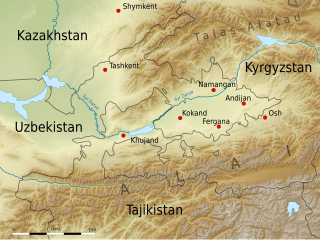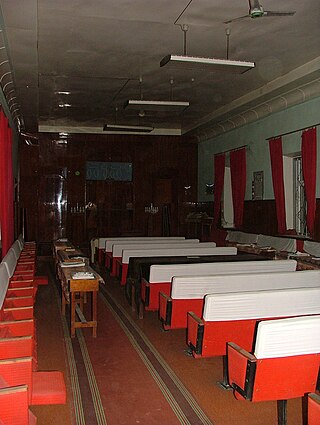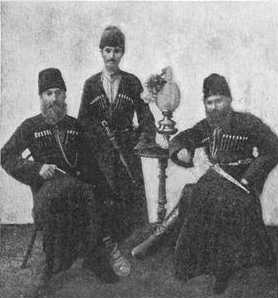
Kyrgyzstan, officially the Kyrgyz Republic, is a landlocked country in Central Asia, lying in the Tian Shan and Pamir mountain ranges. Bishkek is the capital and largest city of the country. Kyrgyzstan is bordered by Kazakhstan to the north, Uzbekistan to the west, Tajikistan to the south, and China to the east and southeast. Ethnic Kyrgyz make up the majority of the country's 7 million people, followed by significant minorities of Uzbeks and Russians.

The Fergana Valley in Central Asia lies mainly in eastern Uzbekistan, but also extends into southern Kyrgyzstan and northern Tajikistan.

Bukharan Jews, in modern times called Bukharian Jews, are an ethnoreligious Jewish sub-group of Central Asia that historically spoke Bukharian, a Judeo-Tajik dialect of the Tajik language, in turn a variety of the Persian language. Their name comes from the former Central Asian Emirate of Bukhara, which once had a sizable Jewish population. Bukharan Jews are of Persian-Jewish ethnicity, along with the Iranian Jews, Afghan Jews, and the Mountain Jews, all of whom fall under the category of Mizrahi Jews.
Jews and Judaism in Tajikistan have a long and varied history. Many of the Tajik Jews were originally Bukharan Jews.

Bukharian is a Judeo-Persian dialect historically spoken by the Bukharan Jews of Central Asia. It is a Jewish dialect derived from—and largely mutually intelligible with—the Tajik branch of the Persian language.

The Dushanbe Synagogue, also known as the Bukharian Synagogue, located in Dushanbe, the capital of Tajikistan, was constructed in the 19th century in one of the two Jewish Quarters in Dushanbe at the time. It was part of the Jewish community compound, which also included ritual buildings and a school. In February 2006, the Government of Tajikistan began demolition of the Jewish community compound as part of an urban redevelopment plan designed to make way for a new presidential residence, the Palace of the Nation, with adjoining landscaped areas. The demolition of the synagogue was delayed due to international protests and a series of court actions until the end of June 2008, when the old building was finally razed.

Ohr Avner Foundation is a philanthropic foundation that was established in 1992 by the Israeli billionaire and émigré from the former Soviet Union, Lev Leviev and is managed by its Director Rabbi David Mondshine. The foundation was named in memory of Lev Leviev's father Rabbi Avner Leviev. It supports a large network of Jewish educational institutions in the former Soviet Union, such as Jewish day schools, kindergartens and youth camps, a resource center and a teachers training institute.

The history of the Jews in Uzbekistan refers to the history of two distinct communities; the more religious and traditional Bukharan Jewish community and the Ashkenazi community.
Gavriel Aronovich Mullokandov is widely regarded as the greatest Bukharian Jewish singer and musician. He was the People's Artist of Uzbekistan.

Soviet Central Asia was the part of Central Asia administered by the Soviet Union between 1918 and 1991, when the Central Asian republics declared independence. It is nearly synonymous with Russian Turkestan in the Russian Empire. Soviet Central Asia went through many territorial divisions before the current borders were created in the 1920s and 1930s.

Uzbek cuisine shares the culinary traditions of peoples across Central Asia. There is a great deal of grain farming in Uzbekistan, so breads and noodles are of importance, and Uzbek cuisine has been characterized as "noodle-rich". Mutton is a popular variety of meat due to the abundance of sheep in the country and it is a part of various Uzbek dishes.

The history of the Jews in Azerbaijan dates back many centuries. Today, Jews in Azerbaijan mainly consist of three distinct groups: Mountain Jews, the most sizable and most ancient group; Ashkenazi Jews, who settled in the area during the late 19th-early 20th centuries, and during World War II; and Georgian Jews who settled mainly in Baku during the early part of the 20th century.

Architecture of Central Asia refers to the architectural styles of the numerous societies that have occupied Central Asia throughout history. These styles include a regional tradition of Islamic and Iranian architecture, including Timurid architecture of the 14th and 15th centuries, as well as 20th-century Soviet Modernism. Central Asia is an area that encompasses land from the Xinjiang Province of China in the East to the Caspian Sea in the West. The region is made up of the countries of Kazakhstan, Uzbekistan, Tajikistan, Kyrgyzstan, and Turkmenistan. The influence of Timurid architecture can be recognised in numerous sites in Kazakhstan and Uzbekistan, whilst the influence of Persian architecture is seen frequently in Uzbekistan and in some examples in Turkmenistan. Examples of Soviet architecture can be found in Uzbekistan, Kazakhstan, Tajikistan and Kyrgyzstan.
Bukharan Jewish cuisine is the traditional cuisine originating from the Bukharian Jewish community of Central Asia, who now mostly reside in Israel, and the United States.
Chala is an Uzbek term meaning "neither this nor that," referring to Bukharan Jews who were coerced into converting to Islam from the late eighteenth century onwards. In response, these Chala Jews outwardly practiced Islam, but secretly retained their Jewish traditions. These crypto-Jews married among themselves and lived in their own separate neighborhoods that bordered on existing Jewish neighborhoods. The Chala Jews carry a very similar story to the Dönmeh and to the Marranos of Spain.
The History of the Jews in Colombia begins in the Spanish colonial period with the arrival of the first Jews during the Spanish colonization of the Americas.
The history of the Jews in Central Asia dates back centuries, where Jews have lived in countries which include Kyrgyzstan, Kazakhstan, Tajikistan, Turkmenistan, and Uzbekistan.

Bukharan Jews in Israel, also known as the Bukharim, refers to immigrants and descendants of the immigrants of the Bukharan Jewish communities, who now reside within the state of Israel.
Central Asians in the United States are Americans with ancestry from Central Asia. They include Kazakh, Kyrgyz, Tajik, Turkmen, and Uzbek individuals. People of Afghan, Baloch, and Uyghur descent are also sometimes classified as Central Asians. The United States census does not mention Central Asians under any category.
Ⱨajoti Miⱨnati, later Adabijoti Soveti, was a Jewish-Bukharian literary and sociopolitical bimonthly journal published in Tashkent in the Uzbek SSR from 1931 to 1941. It was an organ for the Bukharian-Jewish section of the Union of Writers of the Uzbek SSR. Its editors were Aron Saidov, Menashe Aminov and Yunatan Kurayev.










